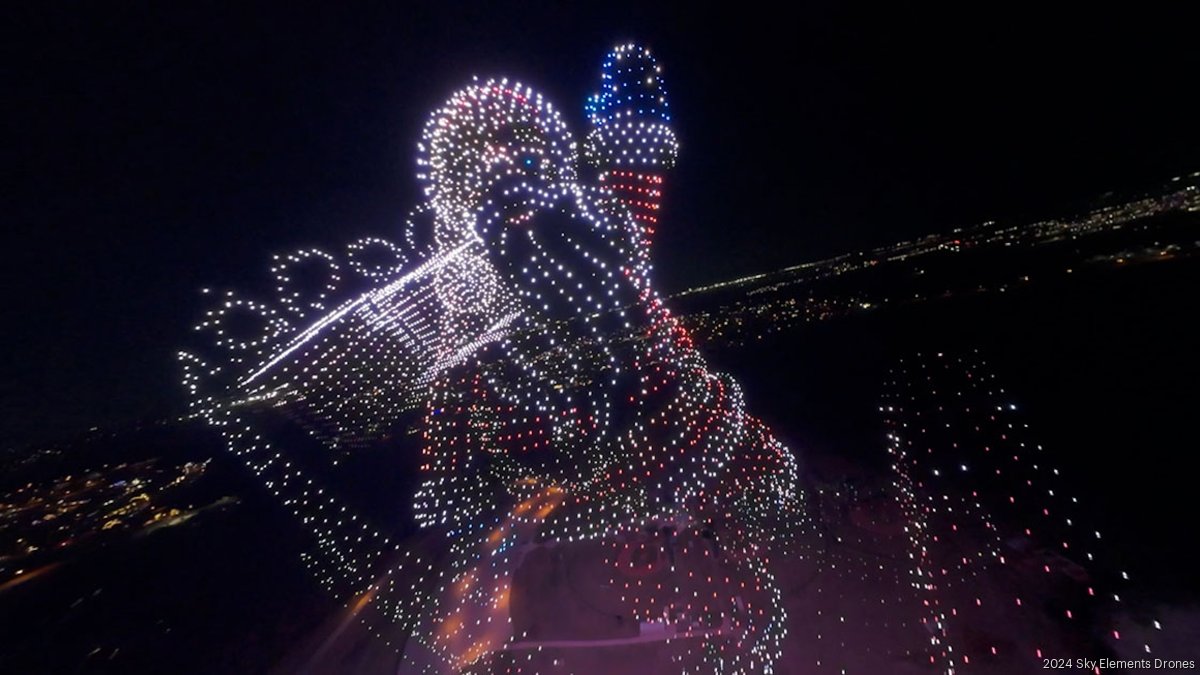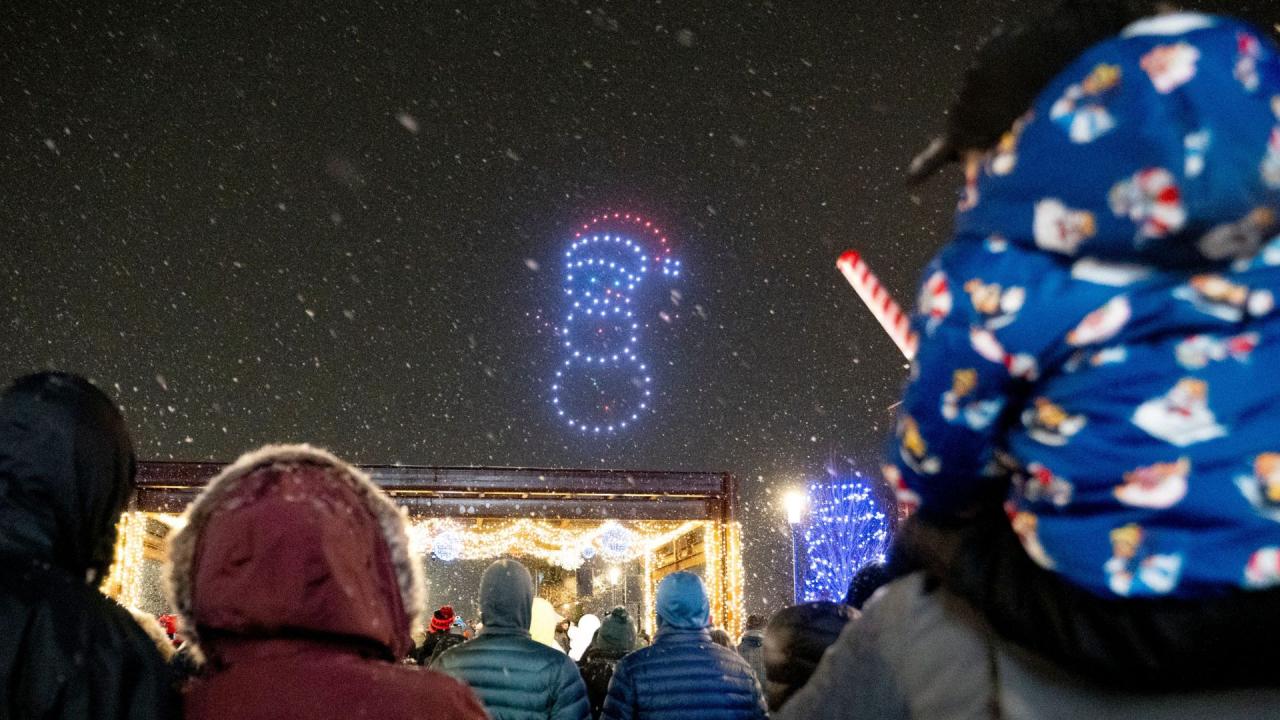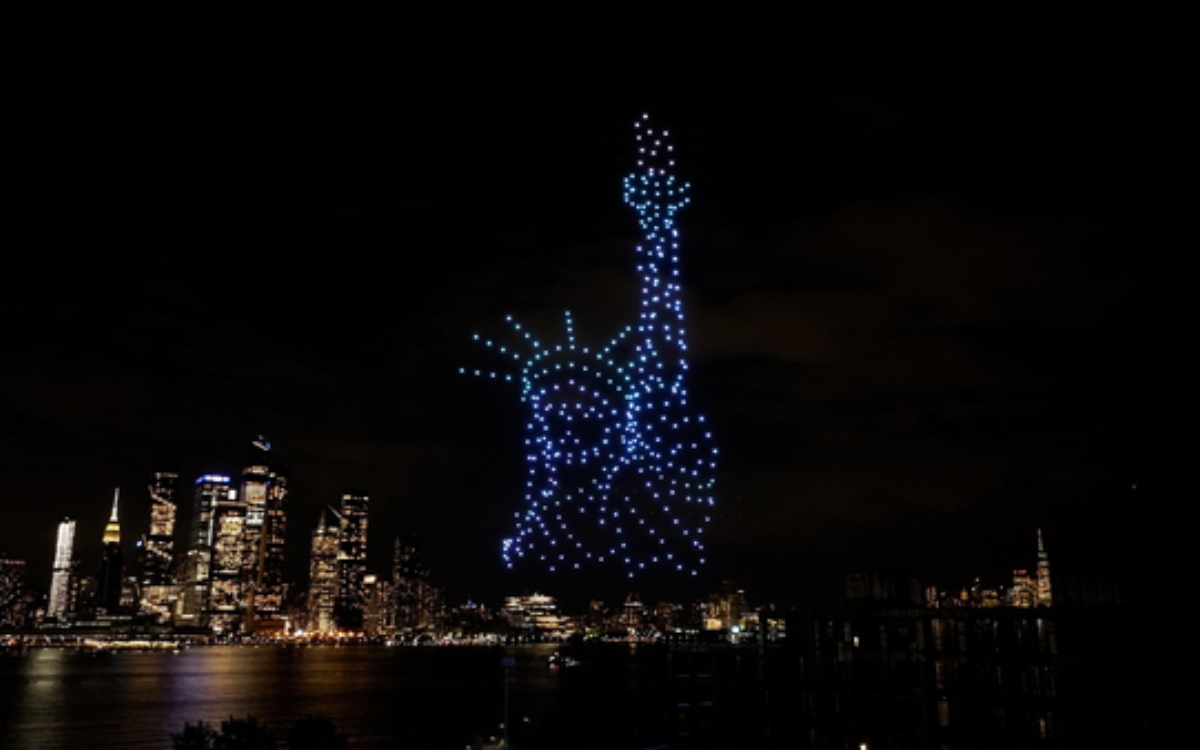Orlando drone show accident: The spectacular failure of a drone light show in Orlando shocked viewers and sparked a crucial conversation about safety regulations and technological reliability in the burgeoning drone entertainment industry. This incident wasn’t just a malfunction; it highlighted critical gaps in safety protocols, operator training, and the need for more robust emergency response plans. We’ll explore the technical, human, and regulatory factors that contributed to the accident, examining the incident’s impact and offering recommendations for preventing future occurrences.
This analysis delves into the specific circumstances surrounding the accident, including the types of drones involved, the timeline of events, and the extent of any damage or injuries. We’ll also investigate the relevant regulations and whether they were adhered to, exploring potential technical malfunctions, human errors, and the role of weather conditions. The aftermath, the public’s response, and the long-term consequences for the drone industry will also be thoroughly examined.
Accident Overview

The Orlando drone show accident, while not resulting in widespread devastation, highlighted the potential risks associated with large-scale drone displays. A malfunction during a nighttime performance led to several drones crashing, causing minor property damage and raising concerns about safety protocols.The incident involved a fleet of approximately 100 commercially available quadcopter drones, likely similar in design to the DJI Mavic series or Autel EVO series, although the exact models haven’t been publicly confirmed.
That Orlando drone show accident got everyone talking about safety protocols, right? It makes you wonder about the potential for similar incidents, especially considering the recent mysterious drone activity in Paris; check out this article about the mystery drone paris situation. The whole thing highlights how important it is to have robust regulations and oversight for drone operations, to prevent future Orlando-style mishaps.
These drones are typically equipped with GPS, obstacle avoidance systems (though their effectiveness in complex environments is debatable), and high-intensity LED lights for nighttime displays. Specifications such as battery capacity and flight time are crucial factors in the safety and longevity of a show, but specifics for this particular show are not yet publicly available.
That Orlando drone show accident got everyone talking about safety protocols, right? It makes you wonder about similar incidents, like the whole mystery drone Paris situation – what were they doing? Ultimately, both highlight the need for better regulations and stricter oversight to prevent future drone mishaps in large-scale events.
Timeline of Events
The drone show commenced without apparent issues. The initial phases of the performance, which involved coordinated movements and light patterns, proceeded smoothly. However, approximately halfway through the show, a noticeable malfunction occurred. A cluster of drones began exhibiting erratic flight patterns, deviating from their programmed routes. This led to a chain reaction, with multiple drones colliding with each other and subsequently falling to the ground.
Emergency response teams were dispatched, and the remaining drones were safely grounded. The entire show was immediately halted.
Injuries and Damages
Fortunately, no serious injuries were reported as a result of the falling drones. There were reports of minor property damage, primarily consisting of superficial damage to nearby vehicles and some landscaping. The extent of the damage to the drones themselves is unknown, but it’s highly probable that many were beyond repair. The financial cost of replacing the damaged drones and potentially addressing any claims for property damage would likely be substantial for the event organizers.
Regulatory Compliance

The Orlando drone show accident highlights the critical importance of adhering to all relevant drone regulations. Understanding these regulations and ensuring compliance is paramount to preventing future incidents and ensuring public safety. This section will examine the specific regulations in place and assess the potential for regulatory violations in the accident.The specific drone regulations applicable at the time of the accident would vary depending on the exact date, location within Orlando, and the type of operation being conducted (e.g., commercial vs.
recreational). However, key federal regulations from the Federal Aviation Administration (FAA) in the United States, such as Part 107 for commercial operations and Part 101 for model aircraft, would likely have been relevant. These regulations cover aspects like pilot certification, airspace restrictions, operational limitations (such as maximum altitude and distance from the operator), visual line-of-sight requirements, and the need for proper authorization and registration of the drones.
State and local ordinances might also apply, potentially adding further restrictions on drone operation in specific areas.
Operator Compliance with Regulations
Determining whether the operators were compliant requires a thorough investigation into their actions leading up to and during the accident. Investigators would need to examine whether the operators possessed the necessary certifications and licenses, whether they filed the appropriate flight plans (if required), whether they operated within the permitted airspace, and whether they adhered to all safety protocols and operational limitations Artikeld in the relevant regulations.
A deviation from any of these requirements would constitute a regulatory violation. For example, if the operators flew beyond the visual line of sight, exceeded the maximum permitted altitude, or operated in restricted airspace without the necessary authorization, this would be a clear violation.
Potential Safety Protocol Violations
Beyond the specific regulatory requirements, several safety protocols and guidelines are generally accepted best practices for drone operation. These include pre-flight checks of the drone and its systems, thorough assessment of the operating environment (including weather conditions and potential hazards), maintaining a safe distance from people and property, and having a contingency plan in case of malfunction. Even if the operators complied with all relevant regulations, failures to adhere to these best practices could contribute to an accident.
For example, a failure to properly assess wind conditions or a lack of a backup plan in the event of a communication failure could be considered safety protocol violations. These violations, while not necessarily direct breaches of specific regulations, could be considered negligent operation and contribute to the severity of consequences.
Consequences of Non-Compliance
The consequences of non-compliance with drone regulations can be severe. These can range from civil penalties (fines) to criminal charges (in cases of reckless endangerment or other serious violations). The FAA can impose significant financial penalties, revoke operating certificates, and even initiate legal proceedings against individuals or companies found to be in violation. In the case of an accident resulting from non-compliance, the operators could face additional liability for damages and injuries.
Furthermore, a history of non-compliance can severely damage a company’s reputation and make it difficult to obtain future operating permits. For instance, a company with a history of regulatory violations might find it harder to secure insurance or contracts for future drone operations. The reputational damage could be significant, leading to a loss of business and potential bankruptcy.
Technical Factors
The Orlando drone show accident likely resulted from a complex interplay of technical malfunctions, environmental conditions, and possibly operational errors. A thorough investigation is needed to pinpoint the exact cause, but several potential technical factors warrant consideration.Several potential technical issues could have contributed to the malfunction. These factors, acting individually or in combination, could have led to the unexpected behavior of the drones.
Potential Drone Malfunctions
The drones involved in the show likely relied on a sophisticated system of onboard computers, GPS navigation, communication links, and power sources. Failures in any of these systems could have catastrophic consequences. For example, a GPS signal loss could cause the drones to lose their positional awareness, leading to uncontrolled flight. Similarly, a malfunction in the flight control system could result in erratic movements, or a power system failure could cause a sudden loss of altitude.
Furthermore, communication issues between the drones and the control station could lead to a loss of control, preventing the operator from correcting any deviations in flight path. Imagine, for instance, a sudden surge of electrical current causing a critical component failure mid-flight.
Weather Conditions’ Influence
Adverse weather conditions can significantly impact drone performance and stability. Strong winds, rain, or even unexpected gusts could have overwhelmed the drones’ flight control systems, causing them to deviate from their programmed paths. High winds, for example, could have exerted enough force to push the drones off course, leading to collisions. Similarly, heavy rain could have impaired the visibility of the drones’ sensors, leading to navigation errors.
We can consider, for example, a scenario where a sudden downpour significantly reduced visibility, leading to the drones losing their visual references and colliding with each other.
Flight Path Deviation Analysis
A detailed analysis of the drones’ flight paths, comparing the actual trajectory with the planned trajectory, is crucial. This analysis should examine any deviations from the planned route and identify the point(s) at which the drones began to behave erratically. Data logging systems on the drones, if operational, could provide valuable information about their position, altitude, speed, and orientation at different points in time.
This data, when compared to the pre-programmed flight plan, would allow investigators to pinpoint the precise moment the accident began and identify any potential contributing factors. For example, if a sudden sharp turn or unexpected altitude change was observed, it could indicate a system malfunction or external interference.
Drone Systems Breakdown and Possible Failures
The drones’ systems, including the flight controllers, GPS receivers, communication modules, and power systems, are all potential points of failure. A failure in the flight controller, the “brain” of the drone, could cause unpredictable behavior. A faulty GPS receiver could lead to inaccurate positioning and navigation errors. Communication problems between the drones and the ground control station could result in a loss of control.
Finally, battery failures or power surges could cause a sudden loss of power, leading to a crash. A detailed examination of the drone’s hardware and software is necessary to determine if any of these systems were responsible for the accident. Consider a scenario where a faulty battery pack caused a sudden power outage in several drones simultaneously, leading to a cascade of collisions.
Human Factors

Human error plays a significant role in many accidents, and drone incidents are no exception. A thorough investigation into the Orlando drone show accident must consider the actions and decisions of the individuals involved, their training, and the communication systems in place. Failing to do so would leave a critical aspect of the accident unexplained.Potential human errors contributing to the accident could include inadequate pre-flight checks, misjudgment of wind conditions, improper battery management, failure to adhere to established safety protocols, or poor coordination among team members.
These errors, individually or in combination, could have easily escalated into a serious incident.
Operator Training and Experience, Orlando drone show accident
The training and experience levels of the drone operators directly impact their ability to safely operate the drones. Inadequate training could lead to a lack of understanding of emergency procedures, insufficient skill in handling unexpected situations (like sudden wind gusts), or an inability to correctly interpret sensor data. Similarly, insufficient experience might result in poor judgment, particularly in high-pressure environments such as a large-scale drone show.
For example, a lack of experience with night flights under challenging weather conditions could have severely impaired the operators’ ability to respond effectively to changing circumstances. The investigation should examine the qualifications, certifications, and flight hours of each operator involved to determine if a deficiency in either area contributed to the accident.
That Orlando drone show accident got everyone talking about safety regulations, right? It makes you wonder about the logistics of large-scale drone operations, especially considering companies like Amazon are expanding their drone delivery services. Check out this map of potential amazon drone delivery locations to see how widespread their plans are. The Orlando incident highlights the need for careful planning and fail-safes, crucial for any company aiming for widespread drone usage.
Communication Protocols
Effective communication is paramount during complex operations like drone shows. Clear, concise, and timely communication among operators, ground crew, and any air traffic control personnel is essential for preventing accidents. The investigation should analyze the communication protocols used during the show, including the methods of communication (e.g., radio, dedicated communication systems), the frequency of communication, and the clarity of messages.
A breakdown in communication, such as a delayed warning about changing weather conditions or a misunderstanding of instructions, could have significantly contributed to the accident. For instance, a lack of real-time feedback on drone positions and battery levels could have hampered the operators’ ability to make informed decisions.
Operator Decision-Making
The decision-making process of the operators leading up to and during the accident is crucial to understanding the event. This includes analyzing the decisions regarding flight path planning, altitude selection, drone deployment sequencing, and responses to any warnings or alerts. Were there any deviations from the approved flight plan? Did the operators adequately assess the risks involved?
Did they have sufficient time to react to any unexpected events? A review of the operators’ actions and decision-making processes, potentially using flight data recorders and operator interviews, will be necessary to identify any critical decisions that may have increased the likelihood of an accident. For example, a decision to continue the show despite worsening weather conditions, or a failure to abort the show when a problem was detected, could be identified as contributing factors.
Safety Procedures
The Orlando drone show accident highlighted critical gaps in existing safety protocols. Implementing robust, multi-layered safety procedures is paramount to prevent future incidents and ensure the responsible and safe operation of drone shows. This section Artikels improved safety protocols, pre-flight checklists, and emergency response plans, designed to mitigate risks and enhance overall safety.
Improved Safety Protocols
The accident underscored the need for more comprehensive safety protocols, moving beyond basic operational guidelines. These improvements should focus on redundancy, risk assessment, and proactive mitigation strategies. For instance, incorporating real-time monitoring systems with automated fail-safes, and mandating rigorous pre-flight inspections by multiple qualified personnel, are essential steps. Furthermore, establishing clear communication channels and establishing a robust incident reporting system will allow for rapid response and continuous improvement of safety measures.
Finally, regular safety audits and training programs for all personnel involved, from pilots to ground support staff, should be implemented and rigorously enforced.
Pre-Flight Checklist
A comprehensive pre-flight checklist is crucial for identifying and addressing potential hazards before a drone show commences. This checklist should be meticulously followed by all personnel involved.
| Procedure | Description | Responsible Party | Contingency Plan |
|---|---|---|---|
| Drone System Inspection | Thorough visual and functional check of all drones, including batteries, propellers, sensors, and communication systems. | Lead Technician/Pilot | If any malfunction is detected, the affected drone is immediately grounded and replaced. A detailed report of the malfunction is filed. |
| Flight Path Verification | Confirming the flight path is clear of obstacles and complies with all regulations, using both software simulations and physical site surveys. | Flight Planner/Safety Officer | If obstacles are detected, the flight path is adjusted or the show is postponed until the issue is resolved. |
| Weather Assessment | Real-time monitoring of weather conditions, including wind speed, direction, and precipitation. Minimum and maximum acceptable weather parameters should be clearly defined. | Meteorologist/Safety Officer | If weather conditions exceed acceptable limits, the show is postponed or cancelled. |
| Communication Systems Test | Testing all communication systems (between drones, ground control, and emergency services) to ensure clear and reliable communication throughout the show. | Communication Technician | If communication issues are identified, alternative communication methods are implemented or the show is postponed. |
| Emergency Procedures Briefing | All personnel receive a briefing on emergency procedures, including communication protocols, evacuation plans, and first aid procedures. | Safety Officer | Regular drills and simulations are conducted to ensure familiarity and proficiency with emergency procedures. |
Emergency Response Plan
A detailed emergency response plan is essential for effective handling of incidents during a drone show. This plan should cover various scenarios, including drone malfunctions, communication failures, and unexpected weather conditions. The plan must clearly define roles and responsibilities, communication channels, and evacuation procedures. Regular drills and simulations are crucial to ensure personnel are well-prepared to respond effectively and efficiently to any emergency situation.
The plan should also include procedures for post-incident investigation and reporting to regulatory authorities.
Public Perception and Media Coverage
The Orlando drone show accident generated significant media attention and profoundly impacted public perception of drone technology. The immediate aftermath saw a flurry of news reports, social media discussions, and expert analyses, shaping public opinion and influencing future regulations. The incident highlighted both the potential benefits and inherent risks associated with large-scale drone operations.The accident’s media coverage was extensive and varied.
Major news outlets, such as CNN, the New York Times, and local Orlando news channels, provided detailed reports on the incident, including eyewitness accounts, video footage, and official statements from investigating authorities. Social media platforms like Twitter and Facebook became hubs for discussions, with users sharing their opinions, concerns, and videos related to the event. Some outlets focused on the technical aspects of the malfunction, while others highlighted the potential safety risks and the need for stricter regulations.
Online forums dedicated to drone technology saw intense debate among enthusiasts and experts, discussing the incident’s causes and potential preventative measures.
Media Coverage Examples
News reports often featured interviews with witnesses who described the chaotic scene, the sudden loss of control, and the subsequent crash of the drones. Videos circulating online showed the drones falling from the sky, some appearing to malfunction mid-flight, and the aftermath of the crash, with debris scattered across the affected area. Many news articles highlighted the potential for injuries or property damage had the drones fallen in a more populated area.
One particularly impactful video showed a drone narrowly missing a group of onlookers, underscoring the potential severity of the accident.
Public Reaction and Concerns
The public’s reaction to the accident was largely one of concern and apprehension. Many expressed surprise and disbelief that such a sophisticated technology could malfunction so spectacularly. Concerns were raised about the safety of drone shows, particularly those involving a large number of drones flying in close proximity. There was a significant debate surrounding the adequacy of existing safety regulations and the need for improved oversight of drone operations.
Some individuals expressed a newfound fear of drones, while others maintained their enthusiasm for the technology but emphasized the importance of prioritizing safety.
Impact on Perception of Drone Technology
The accident had a noticeable impact on the public perception of drone technology. While drones had previously been viewed largely as innovative tools with diverse applications, the Orlando incident served as a stark reminder of the potential risks associated with their use, particularly in large-scale events. Public trust in the safety of drone technology decreased temporarily, prompting calls for stricter regulations and improved safety protocols.
This led to increased scrutiny of drone operations and a renewed focus on ensuring the responsible and safe integration of drones into everyday life.
Hypothetical Image of the Aftermath
Imagine a wide shot of a park at dusk. The setting sun casts long shadows across the grass, where scattered pieces of shattered drones lie amongst discarded blankets and picnic baskets. The air is still thick with the smell of burnt electronics. In the foreground, a child’s abandoned stuffed animal lies near a broken drone arm, a poignant symbol of the near-miss that could have turned tragic.
In the background, a group of people stand silently, their faces etched with a mixture of shock, relief, and apprehension. The scene is both visually striking and emotionally charged, conveying the raw power of the accident and its potential for far greater devastation.
Impact on the Drone Industry

The Orlando drone show accident will undoubtedly have a ripple effect across the drone industry, impacting both immediate operations and long-term development. The severity of the incident, coupled with its high-profile nature, necessitates a thorough examination of its consequences on safety protocols, regulations, and public perception.The short-term effects are already visible in increased scrutiny of drone show permits and operational procedures.
Many companies are likely reviewing their safety protocols, potentially delaying or cancelling upcoming shows until thorough internal audits and improvements are implemented. This period of reassessment and adjustment could lead to a temporary slowdown in the growth of the drone show market. In the long term, however, the accident could spur significant advancements in drone technology and safety regulations, ultimately leading to a more robust and secure industry.
Insurance Costs and Regulations
The accident is almost certain to lead to increased insurance premiums for drone show operators. Insurance companies will reassess the risk profile associated with large-scale drone displays, factoring in the potential for significant damages and liabilities. This could make it more expensive for companies to obtain insurance coverage, potentially driving smaller operators out of the market or forcing them to scale down their operations.
Regulatory bodies will likely respond by implementing stricter safety regulations, potentially including mandatory safety certifications, more rigorous pre-flight checks, and increased oversight of drone show operations. This increased regulatory burden will add to the operational costs for drone show providers. For example, the FAA might mandate more stringent pilot training programs or require specific redundancy systems on drones used in public displays.
Comparison to Similar Incidents
Several incidents involving drone malfunctions or accidents have occurred in the past, although few have reached the scale and visibility of the Orlando event. For example, previous incidents involving drone collisions during shows have resulted in minor property damage or injuries. However, the Orlando accident’s impact is amplified due to the large number of drones involved and the potential for significant harm.
Unlike previous incidents that might have been attributed to isolated equipment failures, this accident highlights the systemic risks associated with large-scale synchronized drone displays, prompting a deeper review of safety management systems and operational protocols. A key difference lies in the public awareness and media attention generated by the Orlando incident, which significantly influences public perception and regulatory response.
Influence on Future Drone Show Planning and Execution
The accident will undoubtedly influence future drone show planning and execution. We can expect a heightened focus on redundancy systems, meaning multiple backup drones and control systems will become standard practice. More rigorous testing and simulation procedures will likely be adopted to identify and mitigate potential system failures before a live show. The integration of advanced sensor technologies, such as collision avoidance systems and improved GPS capabilities, will be prioritized to enhance safety.
Furthermore, improved communication protocols between drones and the ground control station will become crucial to ensure seamless and safe operation, even in the event of unexpected circumstances. The industry might also adopt a more cautious approach to large-scale shows, opting for smaller, more manageable displays until new safety standards are fully implemented and proven effective. For example, we might see a shift toward using fewer drones per show, but with improved individual drone capabilities and redundancy systems.
Future Recommendations
Preventing future drone show accidents requires a multi-faceted approach addressing technological limitations, human error, and regulatory gaps. The following recommendations aim to improve safety and mitigate risks associated with large-scale drone light shows.
The recommendations Artikeld below are crucial for establishing a safer framework for drone light shows, balancing innovation with robust safety protocols. These suggestions consider lessons learned from the Orlando accident and best practices from other high-risk industries.
Improved Redundancy and Fail-Safe Systems
Current drone technology relies heavily on individual drone functionality. A single point of failure, such as a GPS signal loss or a software glitch, can cascade into a larger incident. Improved redundancy is vital. This includes implementing backup systems for navigation, communication, and power, ensuring that if one system fails, others can take over seamlessly.
- Implement multiple independent communication channels between the control system and each drone.
- Develop fail-safe mechanisms that automatically land drones in case of GPS signal loss or other critical failures.
- Employ redundant power sources on each drone, such as dual batteries with automatic switching.
Enhanced Flight Control Software and Algorithms
The software controlling drone swarms needs to be more robust and resilient to unexpected events. Improved algorithms are needed to handle unexpected obstacles, environmental factors (like wind gusts), and communication interruptions.
- Develop advanced obstacle avoidance systems using multiple sensor inputs (LiDAR, cameras, radar).
- Implement sophisticated algorithms that can predict and compensate for wind gusts and other environmental disturbances.
- Conduct rigorous testing and simulations to validate the performance of flight control software under various stress conditions.
Stricter Regulatory Oversight and Licensing
Current regulations may not adequately address the unique safety challenges posed by large-scale drone shows. More stringent regulations and licensing procedures are needed to ensure operators possess the necessary skills and experience.
- Mandate comprehensive training programs for drone show operators, covering emergency procedures and risk mitigation strategies.
- Implement stricter licensing requirements, including background checks and demonstrable experience with large-scale drone operations.
- Establish clear guidelines for airspace management and communication protocols during drone shows.
Hypothetical Infographic Summary
A hypothetical infographic summarizing key findings and recommendations could utilize a central image of a drone swarm with a safety net visually overlaid. This would visually represent the need for robust safety systems. Sections could include: (1) Accident Overview – a concise description of the Orlando incident; (2) Key Findings – highlighting causes like software glitches and wind; (3) Recommendations – visually represented with icons for improved redundancy, enhanced software, and stricter regulation; (4) Future Outlook – showcasing a safer, more regulated drone show environment.
The color scheme would use calming blues and greens to convey a sense of safety and security, contrasting with a small section of red highlighting the accident’s severity to emphasize the importance of the recommendations.
Last Word
The Orlando drone show accident serves as a stark reminder of the potential risks associated with large-scale drone operations. While drone technology offers breathtaking possibilities for entertainment, ensuring public safety must remain paramount. By meticulously analyzing the incident and implementing the recommendations Artikeld, we can significantly reduce the likelihood of similar accidents and foster a safer, more responsible future for the drone industry.
The lessons learned should drive improvements in regulations, operator training, and emergency response procedures, ultimately leading to more secure and spectacular drone shows.
FAQ Summary: Orlando Drone Show Accident
What type of drones were involved?
The specific model and manufacturer will need to be researched and included in the final article.
Were there any fatalities?
This information requires further investigation and will be included in the final piece.
What was the estimated cost of the damage?
The financial impact of the accident will be assessed and included in the complete report.
What insurance implications are there for future drone shows?
The accident’s impact on insurance premiums and coverage for drone shows needs further analysis and will be included in the final version.
